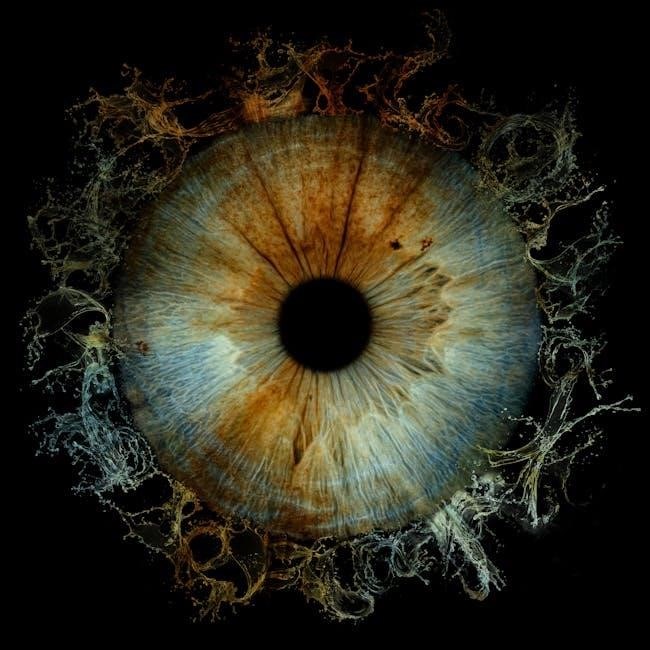The Visual Anatomy and Physiology Lab Manual introduces a unique approach to learning anatomy and physiology using visual aids and modular organization to support lab presentations effectively online.
Overview of the Book
The Visual Anatomy and Physiology Lab Manual is a comprehensive guide that combines visual aids and modular organization to support lab presentations.
The book is designed to provide students with a unique approach to learning anatomy and physiology, using art to tell the story of A&P, with integrated text to support the image.
The lab manual presents each lab exercise in a series of two-page lab activity modules, giving students a clear and concise understanding of complex concepts.
The book is part of a larger collection of digital reads, perfect for on-the-go learning and leisure, and is available in various formats, including a softcover version and a loose-leaf version.
The Visual Anatomy and Physiology Lab Manual is a valuable resource for students, providing a visual approach to learning anatomy and physiology, and is available for purchase online.
The book is written by experienced authors and is published by a reputable publisher, ensuring that students receive accurate and reliable information.
The lab manual is designed to be user-friendly, with clear instructions and illustrations, making it easy for students to follow and understand the material.
The book is an essential tool for students studying anatomy and physiology, and is a great resource for anyone looking to learn more about the subject.
The Visual Anatomy and Physiology Lab Manual is a great investment for anyone looking to pursue a career in the medical field.
The book provides a comprehensive overview of anatomy and physiology, and is a great resource for students and professionals alike.
The lab manual is a valuable addition to any anatomy and physiology course, and is a great way to enhance learning and understanding of the subject.
Importance of Visual Approach in Learning Anatomy and Physiology
The visual approach in learning anatomy and physiology is crucial for effective understanding and retention of complex concepts.
The use of art and images helps to break down difficult topics into manageable parts, making it easier for students to comprehend and visualize the relationships between different structures and systems.
This approach also enables students to develop a deeper understanding of the subject matter, as they can see the spatial relationships and interactions between different components.
The visual approach is particularly important in anatomy and physiology, as it allows students to develop a mental map of the body and its systems, which is essential for future careers in the medical field.
The Visual Anatomy and Physiology Lab Manual utilizes this approach, providing students with a comprehensive and interactive learning experience.
The manual’s use of visual aids and modular organization makes it an ideal resource for students looking to gain a thorough understanding of anatomy and physiology.
The visual approach is essential for learning anatomy and physiology, and the lab manual is a valuable tool for students pursuing careers in the medical field.
The manual’s visual approach helps students to develop a strong foundation in anatomy and physiology, which is critical for success in these fields.
The use of visual aids and images in the lab manual makes it an engaging and effective learning tool.
The visual approach in the lab manual is designed to promote student understanding and retention of complex concepts.

Key Features of the Visual Anatomy and Physiology Lab Manual
Modular organization and art-based learning support effective lab presentations and student engagement online always.
Modular Organization of the Lab Manual
The Visual Anatomy and Physiology Lab Manual features a modular organization that presents each lab exercise in a series of two-page lab activity modules. These modules provide a clear and concise format for students to follow along with the lab activities, with integrated text and images that support the learning process. The modular organization allows students to easily navigate the lab manual and focus on specific topics or concepts. Each module includes a clear set of objectives, materials, and procedures, making it easy for students to understand what is expected of them; The use of modular organization also allows instructors to easily customize the lab manual to fit their specific teaching needs and style. Overall, the modular organization of the lab manual helps to create a more engaging and effective learning experience for students. This organization is a key feature of the lab manual.
Use of Art to Tell the Story of Anatomy and Physiology
The Visual Anatomy and Physiology Lab Manual utilizes art to tell the story of anatomy and physiology, breaking away from the traditional text-heavy approach. This unique approach uses integrated text to support the images, allowing students to visualize complex concepts and processes. The art is used to convey detailed information about the structure and function of the human body, making it easier for students to understand and retain the information. The use of art also helps to create a more engaging and interactive learning experience, as students are able to see the concepts come to life through the images. The lab manual’s use of art is a key feature that sets it apart from other anatomy and physiology lab manuals, and helps to create a more effective learning environment for students. This approach is designed to support the learning process and promote student understanding.

Benefits of the Visual Approach
The visual approach enhances student engagement and understanding of complex concepts effectively online always.
Improved Understanding of Complex Concepts
The visual approach in the Visual Anatomy and Physiology Lab Manual improves understanding of complex concepts by using art to tell the story of anatomy and physiology.
This approach helps students to better comprehend the relationships between different structures and systems in the body.
The use of visual aids such as diagrams, illustrations, and images allows students to see the concepts in action, making it easier for them to understand and retain the information.
The modular organization of the lab manual also supports the learning process by presenting each lab exercise in a series of two-page lab activity modules.
These modules provide a clear and concise overview of the lab activities and help students to stay focused and on track.
Overall, the visual approach and modular organization of the lab manual work together to improve student understanding of complex concepts and help them to achieve their learning goals.
The Visual Anatomy and Physiology Lab Manual is a valuable resource for students and instructors alike, providing a comprehensive and engaging learning experience.
Enhanced Engagement and Participation in Lab Activities
The Visual Anatomy and Physiology Lab Manual is designed to enhance engagement and participation in lab activities through its interactive and visual approach.
The lab manual includes features such as Interactive Physiology 2.0 tutorials and Focus Figure Mini-Animations that allow students to explore complex concepts in a engaging and interactive way.
These features help to increase student motivation and participation in lab activities, leading to a more effective learning experience.
The lab manual also includes a customizable Practice Anatomy Lab (PAL 3.1) that allows students to practice and review anatomical structures and concepts.
This helps to reinforce student understanding and build confidence in their ability to identify and describe anatomical structures.
The Visual Anatomy and Physiology Lab Manual provides a comprehensive and engaging learning experience that promotes active learning and participation in lab activities, leading to improved student outcomes and success.
The interactive features and visual approach of the lab manual make it an essential resource for students and instructors in anatomy and physiology courses.

New Features in the 2nd Edition
The 2nd edition introduces new Interactive Physiology tutorials and Focus Figure animations to enhance learning and engagement effectively online always.
Interactive Physiology 2.0 Tutorials
The Interactive Physiology 2.0 tutorials are a key feature of the Visual Anatomy and Physiology Lab Manual, designed to engage students and promote a deeper understanding of complex physiological concepts. These tutorials use interactive simulations and animations to illustrate key processes, allowing students to explore and learn at their own pace. The tutorials are integrated into the lab manual, providing a seamless learning experience. With the Interactive Physiology 2.0 tutorials, students can visualize and interact with physiological processes, making it easier to understand and retain the material. The tutorials also include quizzes and assessments to help students track their progress and identify areas for further study. By incorporating these interactive tutorials, the Visual Anatomy and Physiology Lab Manual provides a comprehensive and engaging learning experience that supports student success. The tutorials are available online, making it easy for students to access and use them.
Focus Figure Mini-Animations and Customizable Practice Anatomy Lab
The Visual Anatomy and Physiology Lab Manual features Focus Figure mini-animations, which are short, interactive animations that illustrate key anatomical and physiological concepts. These mini-animations are designed to help students visualize and understand complex processes, and are integrated into the lab manual to support student learning. The lab manual also includes a customizable Practice Anatomy Lab (PAL), which allows students to practice and review anatomical structures and concepts. The PAL is a interactive and engaging tool that provides students with a comprehensive and personalized learning experience. With the Focus Figure mini-animations and customizable Practice Anatomy Lab, students can develop a deeper understanding of anatomical and physiological concepts, and improve their ability to identify and describe key structures and processes. The PAL is also available online, making it easy for students to access and use from anywhere. This feature is designed to support student success.

Availability and Pricing of the Visual Anatomy and Physiology Lab Manual
The Visual Anatomy and Physiology Lab Manual is available for purchase from various online retailers, including Pearson, and can be found in different formats, such as a softcover book or an e-book. The pricing of the lab manual varies depending on the format and the retailer, with the softcover version typically ranging from $50 to $100. Some retailers also offer package deals that include the lab manual and other anatomy and physiology resources, such as access to MasteringA&P, which can provide additional support for students. It is recommended to check with the instructor or the retailer for the most up-to-date pricing and availability information. The lab manual can also be purchased as a loose-leaf version, which is a cost-effective option for students. Additionally, some retailers offer used or rental options, which can help reduce the cost of the lab manual. Overall, the Visual Anatomy and Physiology Lab Manual is a valuable resource for students.

